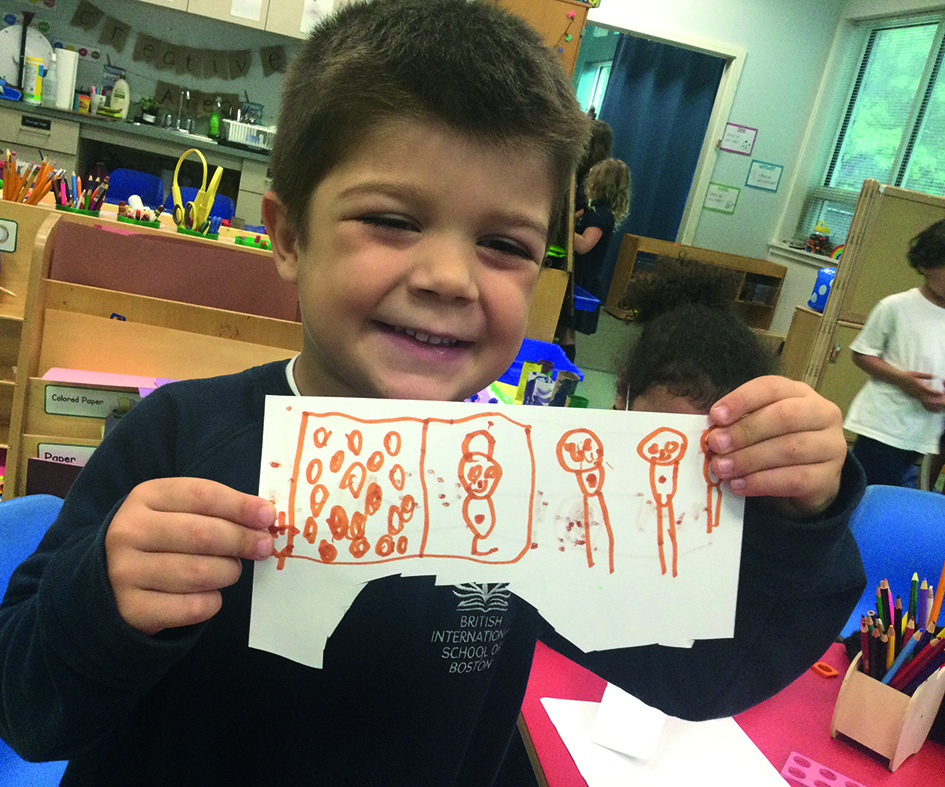
Children are born engaged learners and excited by mark-making, but by the time they reach Year 1, many are reluctant writers. This is often due to adults forcing children to write in a formal way before they are ready. If we step back from an expectation of the ‘correct way to write’, we will find that more children continue to engage with mark-making.
Writing shouldn’t be limited to the writing area. Having clipboards, whiteboards and different types of paper around the different areas of your classroom provides the children with valuable opportunities to engage in mark-making. Ensuring some of these mark-making opportunities are vertical, as well as horizontal, will help develop children’s fine motor control.
We must be mindful that mark-making doesn’t need to have explicit meaning to an adult. A child’s mark has meaning to them, and that makes it valuable.
LITERACY LINKS
As all practitioners know, the key to engaged and excited children is to link their learning to their interests. My class were all very interested in unicorns after a child spotted one on our way to a Forest School session. The entire class got behind the story of Sparkles the unicorn, who now lives in the woods next to school. Using this as a starting point, we followed some clues and unicorn tracks that led to a rainbow.
The children were amazed and the imaginative conversation that came from them was remarkable. Together the children decided that Sparkles was trying to leave them a message, so they very quickly set about leaving their own messages for the unicorn on the playground. Many chose to use chalk to draw rainbows, while others wrote letters. More reluctant mark-makers were swept along by the excitement and joined in with the fun.
After a few days, the children were desperate to see the unicorn, so I used some computer software to record a unicorn running through the playground, which resulted in even more excitement and more letter-writing from the children. From this, the children created their own post box, and using envelopes that were provided for them, the children spent the next few weeks writing messages and pictures to send to the unicorn.
IMAGINATIVE PLAY
 All children enjoy playing imaginative roles that are familiar to them. Quite often, children gravitate towards teacher role play, particularly when they enter Reception. Having a range of ‘teacher resources’ that are just for the teacher is a powerful way to encourage children to mark-make. Providing children with their own registers and class lists, access to the whiteboard and markers will help children to not only develop their social skills and imagination but also their pen grip, control and fine motor skills as well.
All children enjoy playing imaginative roles that are familiar to them. Quite often, children gravitate towards teacher role play, particularly when they enter Reception. Having a range of ‘teacher resources’ that are just for the teacher is a powerful way to encourage children to mark-make. Providing children with their own registers and class lists, access to the whiteboard and markers will help children to not only develop their social skills and imagination but also their pen grip, control and fine motor skills as well.
In my class, the children love playing ‘bus monitor’ and taking on the role of bus supervisor. They had access to clipboards, paper and pens, and junk modelling as well.
Due to the freedom the children had, they were able to make their own walkie talkies and mobile phones and rearrange the chairs in the classroom to create their own bus.
GROSS MOTOR MARK-MAKING
Painting doesn’t have to be limited to small-scale indoor projects. We use our concrete floor outside. This is a great activity to encourage the children not only to mark-make but also develop their gross motor skills through large-scale art.
This activity doesn’t have to be limited to the ground. Our children have also enjoyed painting trees, logs and their playhouse. The great thing about this activity is that once it rains, the children have a blank canvas to start again.
SOUND/WORD HUNTS
The children in our setting enjoy scavenger hunts in all forms, and over the past few years we have incorporated this into our phonics lessons. We tell the children that our class puppet has hidden all their sounds/words in the trees. Armed with a clipboard and pencil, the children love searching for the missing sounds and words and seeing who can write the most down. They love writing on clipboards (‘it makes me feel like a grown-up’). Participating in these kinds of activities not only encourages them to practise writing, butalso encourages phoneme recognition and segmenting and blending skills. Quite often, the children return to this activity during their play.
FURTHER INFORMATION
- Greg Bottrill, author of Can I Go And Play Now?, is doing some amazing work around mark-making. Check out his ‘drawing club’ and ‘scribble club’ training, as well as his work on message centres, at https://www.canigoandplaynow.com/the-message-centre.html
PHOTOS: Claire Martin









